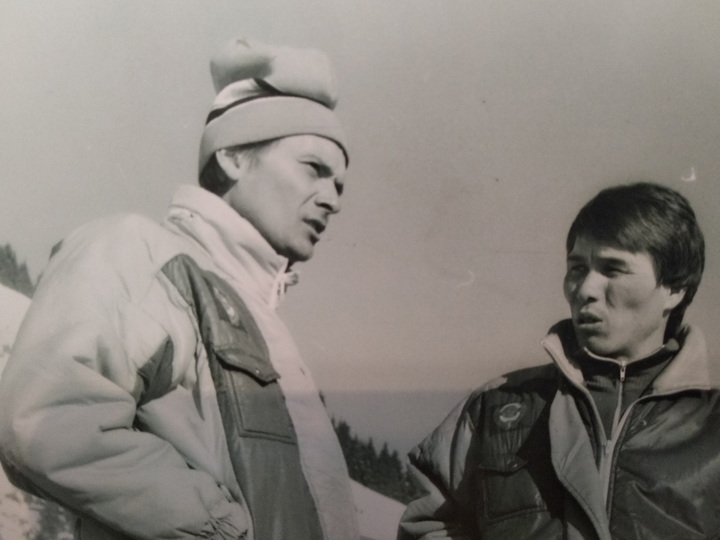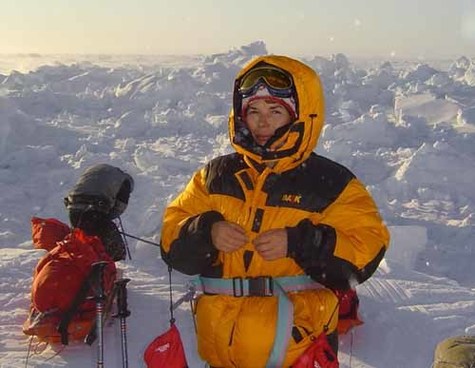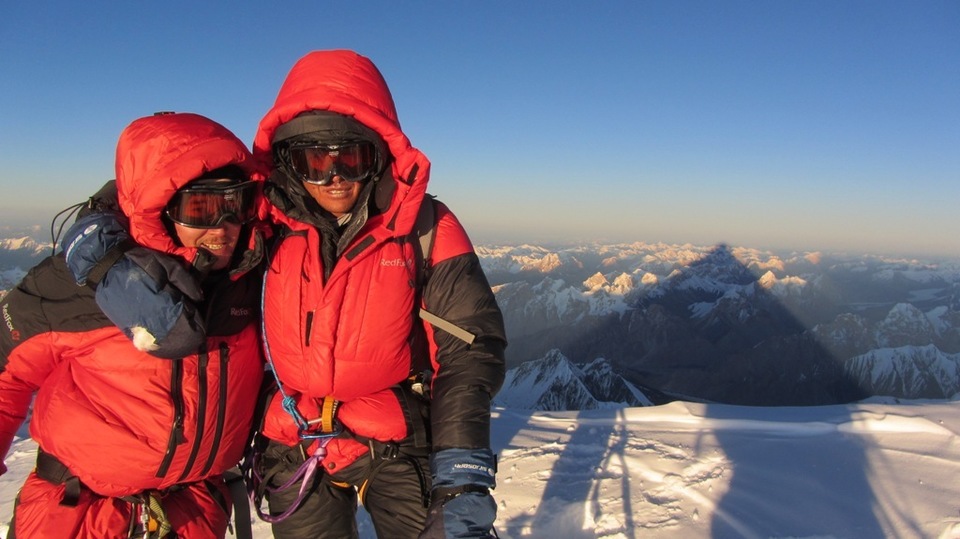Kazakhstanis on Everest – MK Kazakhstan
[ad_1]
The current expedition is dedicated to the 100th anniversary of the outstanding heroes of Kazakhstan: Army General “Halyk Kaharmany” Sagadat Nurmagambetov, “Halyk Kaharmany” Rakhimzhan Koshkarbayev and Hero of the Soviet Union Aliya Moldagulova. The expedition is led by the famous mountaineer Maksut Zhumaev, master of sports of international class, honored master of sports of the Republic of Kazakhstan, climber of all 14 highest peaks in the world, major of the Mountain Training Center of the Special Operations Forces of the Ministry of Defense of the Republic of Kazakhstan. The expedition members promised to give an interview upon their return.
Almaty runners and skyrunners say that Anar Burasheva is a very strong athlete. She is a coach and skyrunner, her achievements are marked by awards for victories in such competitions as Thian Shan trail race (42 kilometers), Tengri ultra (35), Almaty Mountain Half Marathon, Irbis race (42), Red planet Race (30), Almaty Marathon (42), Madeira Island Ultra Trail (60).
Mountaineering instructor Ada Molgacheva wrote on social networks: “Anar completed an initial training course at the Almaty Mountaineering School in the winter season of 2020, passed the exam and made a qualifying ascent to Amangeldy Peak. She received the well-deserved “Mountaineer of Kazakhstan” badge and the first entry in the “Mountaineer’s Book”.
Anar Burasheva climbed routes of the 1st and 2nd categories of difficulty near Almaty, climbed the highest peak of the Trans-Ili Alatau, Talgar Peak (5017 meters), Mont Blanc in the Alps (4809) and Kilimanjaro in Africa (5895).
The height of Everest is 8848 meters. The team will acclimatize to 5000 meters while trekking under Chomolungma (the Tibetan name of the peak). The expedition participants will spend several days at the base camp. Planned climb to Island Peak (6130). Let’s wish the team good luck, may they be lucky with the weather! And we turn to history.

Mountain number one
A year ago, Maria Pavlova from France visited Almaty; she collected material for a scientific work on the topic “Everest-82”. She was interested in how the USSR was able to prepare a top-class team, which, on its Himalayan debut, climbed the most difficult route along the buttress of the southwestern face of Chomolungma. Maria asked Kazbek Valiev how the training system functioned, where were the opportunities for training the strongest climbers.
“Soviet mountaineering as a phenomenon raises many questions in the West,” said Kazbek Shakimovich. — In the USSR, most of the population was involved in amateur sports. Two systems operated in parallel. Trade unions existed on contributions from working residents of the country. Some of the funds were allocated for physical education, and some for voluntary sports societies. The unions paid for the work of the coaches and the gym.
Mountaineering courses, training sessions, gatherings and events for representatives of various fields, as well as mass mountaineering events were organized, which is an active promotion of mountaineering through people. Another branch is student sports. There were sections in different cities that were united under a republican structure.” In the USSR, sport was a mass phenomenon, and quantity almost always turns into quality.
The first climber of all eight-thousand-meter peaks, Reinhold Messner, was convinced that the route along the wall to the highest eight-thousand-meter peak was beyond the power of man, and, by the way, it has still not been repeated. The captain of the Soviet Union team, Valentin Ivanov, wrote: “In 1982, Soviet climbers, who made their debut in the Himalayas, made a significant contribution to the development of wall routes by climbing Everest along the buttresses of the southwestern face. The ascent was highly praised by the most prominent experts on the Himalayas.”
Player coach from Almaty Ervand Ilyinsky was part of the reconnaissance group for choosing the route. “We had to go through the Khumbu Icefall, from there we could already see everything,” recalls Ilyinsky. “Well, when we got there, I looked and joked: “This is the route that will take you to third place in the Union Championship, no higher!” In response I heard: “Something you swung…”
Five Almaty residents took part in the first Soviet Himalayan expedition. The Valiev-Khrishchaty team stormed Everest at night due to hurricane winds, and the leadership ordered Ilyinsky to accompany the pair on the descent. His partner Chepchev could have reached the summit, but the closing trio of Khomutov – Puchkov – Golodov did not dare to take Sergei into the group, since he spent longer at high altitude, and there the strength leaves a person very quickly. So Kazbek Valiev became the first Kazakh to reach the third pole of the Earth.
In 1990, E.T. Ilyinsky was appointed trainer of the international American-Chinese-Soviet expedition to Everest from the north. Under his leadership, the first Soviet and 11th woman in the world, Ekaterina Ivanova, originally from Eastern Kazakhstan, reached the top. Let me remind you that the first woman to set foot on the world dome was the Japanese woman Yunko Taipei in 1975, who, by the way, had been to Kazakhstan and climbed in the Central Tien Shan. And in 1990, Sergei Arsentiev, Anatoly Moshnikov, Grigory Lunyakov and Andrei Tselishchev became the first Soviet climbers to climb Everest without the use of additional oxygen (the first to reach the summit without oxygen were Italian Reinhold Messner and Austrian Peter Habeler in 1978). Coach Ilyinsky also made the ascent, although they did not count on him, bringing oxygen and food to the camps. He carried everything in his backpack.

“Lusya Savina was here. Thank you, Gods!”
Lyudmila Savina wrote two short sentences with a felt-tip pen on a bologna mitten that she left at the top of Everest. When the participants of the Kazakh expedition from the north in 1997 returned home, she said on the phone: “I was abandoned…” And Savina and I wrote the book “Namaste, Everest,” which was based on the diaries of the climbers.
The advance group makes a cargo walk, and Lyudmila goes down. “Now, you’ll go on the assault without me,” she wrote in her diary. To which Vladimir Suviga replied: “It’s unlikely that they will have any strength left.” “He gives me directions on the way down because I’m walking alone. I must find Dima Sobolev and tell him where he is. So, in this crazy wind, they are up and I am down.”
She found Sobolev in the ABC camp. He went down to the base, and Lyudmila remained to wait for the advance group. “The mountain is very large in length and elevation gain. Danger brings people together, and now I feel an inextricable connection with those at the top. I learned through communication that tomorrow they were going on an assault. Three with oxygen, Suviga without oxygen.”
Suviga’s group – Sergei Ovcharenko, Andrei Molotov and Vladimir Frolov – passed the second stage on May 2 at 14.00. Lyudmila thought: if they manage to descend to a height of 7800 before dark, consider that they will be home. But the climbers started their assault late, did not meet the daylight hours and spent the night on the ridge. As they say, they grabbed a cold one. Suviga told Ilyinsky that his ribs were broken and everyone had vision problems. They lost a lot of time on the first step, where there was no rope, and reached the top at 18.30. Therefore, we had to go down at night. “Darkness fell immediately after the first step,” Suviga wrote in his diary. – We’ve been walking for a very long time.
Frolov began to talk – he had run out of oxygen. I notice some tricks behind my consciousness – then fantasies flare up, then memories, then reality again. Volodya Frolov and his imaginary partner simply walked away while I was looking for the descent. At one point I fell off a cliff and fell straight onto a stone. So we spent time until the morning. I’m under a stone, Sergei and Andrey are above a stone, Volodya is unclear where.” Luckily, Frolov reached the tents at 7800, but his nose and legs were frostbitten. The rest came there too.
Expeditions that take place in a “siege” style, process the route with fixed ropes and set up camps at different heights. After setting up camp at 8300, Suviga’s group had to descend to the base and in this case would have been at the back of the queue to the summit. We decided to take the chance and go on an assault after setting up the camp, and since we didn’t really believe in such a possibility, we took one oxygen cylinder each, and it ran out already in the area of the summit, and in this case, a person at a great height is exposed to the harmful effects of the environment.
“After another fall, I lost sight of the guys,” Frolov wrote. — We walked on autopilot and called to each other in the dark. I went out onto the snowy slope and began to look for a place where I could sit until dawn. On the ridge I saw boots – there was a place protected from the wind by a stone. Apparently, the owner of the shoes also sat down for a short time and stayed forever. I found a stone on the slope, put down my backpack, drove in an ice ax, and lay down.”
“When Kostya Farafonov and I went ahead, leaving Lyusya Savina, we did not behave like gentlemen, but we did not leave anyone to die. Everyone has their own pace. Everyone wants to climb, and how to do it is everyone’s problem,” Lavrov wrote. They launched the assault as a foursome – Lavrov, Farafonov, Sobolev, Savina. Lavrov and Farafonov went ahead, and already on the descent from the top they met “three Dimons” – Grekov, Muravyov, Sobolev, Savina was with them.
“Lavrov and Farafonov in a team went ahead,” said Dmitry Muravyov. “We already thought that Sobolev had gone down.” And then Lucy came up. We asked her: “Are you abandoned?” And they themselves answered: “You were abandoned.” We fastened Lucy to our rope, and Sobolev appeared. They also strapped him in. When the last throw remained to the top, we walked together with Lyusya.” On the descent, Muravyov dug out a half-empty oxygen cylinder that someone had thrown out of the snow and gave it to the woman. Grekov gave the remaining oxygen he had to Sobolev, who felt worse than others. In that expedition, 10 people reached the summit.
Anatoly Boukreev was without oxygen on Everest four times. Interestingly, Probowo Subianto, who led the 1997 Indonesian military expedition to Everest, became president of his country, and negotiations are now underway to hold an exhibition of Boukreev’s photographs taken on that expedition in Jakarta.

In 2000, Denis Urubko first went to the Himalayas to climb the eight-thousander Lhotse, adjacent to Everest. A Russian businessman he met paid him a permit to climb Everest, and Urubko climbed to the top.
The second Kazakh on Everest was Maksut Zhumayev. Together with their partner Vasily Pivtsov, they climbed from the north in 2007. It is noteworthy that in the 2000s, Kazakhstani athletes worked on eight-thousanders without the use of additional oxygen.
“What seems meaningless sometimes has deep meaning. This is the only justification for seemingly aimless actions,” wrote the first climber of the eight-thousander, Maurice Herzog. People who voluntarily break the chains of civilization return to their roots. And it’s not for nothing that they say that in the mountains you eat your pound of salt with a partner faster.
[ad_2]
Source link









